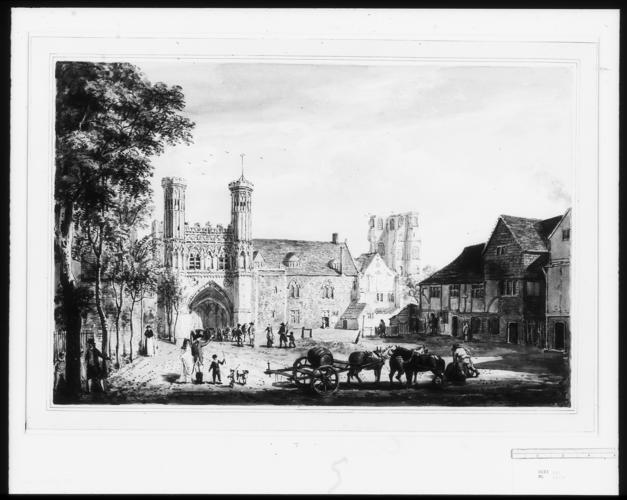The Great Gateway of St Augustine's Monastery, Canterbury c. 1782 - c. 1786
Pencil, pen and ink, watercolour and bodycolour | 33.2 x 50.7 cm (sheet of paper) | RCIN 914719
-
A pencil, pen and ink and watercolour drawing of the Great Gateway of St Augustine's Monastery in Canterbury. Houses in the foreground in Lady Wootton's Green, with figures in the square. A man unloading barrels from a horse and cart. On a wash-line bordered mount.
Paul Sandby was Chief Drawing Master at the Royal Military Academy in Woolwich from 1768 until 1796, and rented lodgings nearby in Old Charlton. From there, Canterbury was about a day's journey and he made several views of Kent subjects. The Great Gate, or Fyndon's Gate in Canterbury was built in 1301-9. A chamber in the gateway was slept in by Charles I and Henrietta Maria after their wedding at Canterbury Cathedral. Lady Wootton's Green, now a grassy area in front of the Gate, is named after the wife of Edward, Lord Wootton of Marley, who owned the abbey buildings in the seventeenth century. Sandby's scene is enlivened with figures from everyday life, providing a contrast with the ruined backdrop.The attention paid to the topography of the medieval ruins is part of a general interest among artists and antiquarians in this period in recording British topography and historical monuments, especially as many were being dismantled to make way for modern improvements. An increase in domestic and leisure tourism also supplied the market with demand for views of Britain's abbeys, castles and landscapes, such as those in Sandby's print series the Virtuosi's Museum. Ruined abbeys had a particular resonance, in part for their aesthetic appeal to picturesque taste, but also as a reminder of their place in shaping the narrative of Britain's history and nationhood.
In 1786 Sandby exhibited views of St Augustine's Monastery at the Royal Academy, and published two aquatints in 1782. A drawing of the St George's or Cemetery Gate is in the Tate Gallery (N01856), also dated 1782, and another (that exhibited at the RA in 1786) was sold at Christie's 11 November 1997, lot 9. Oppé suggests that the present work might be later in date on grounds of costume and style, but a date of the 1780s seems likely.Provenance
Probably Paul Sandby estate sale, 2-4 May 1811, first day, lot 36 'A View of the Cemetery Gate and Part of the Monastery of St Augustine at Canterbury'; bought for the Prince Regent by Colnaghi
-
Creator(s)
Acquirer(s)
-
Medium and techniques
Pencil, pen and ink, watercolour and bodycolour
Measurements
33.2 x 50.7 cm (sheet of paper)
Other number(s)
RL 14719









